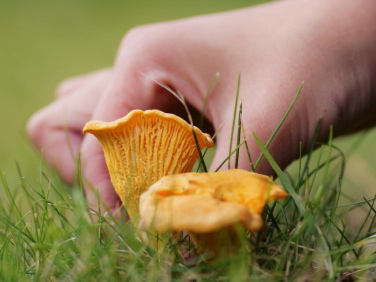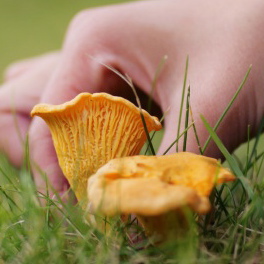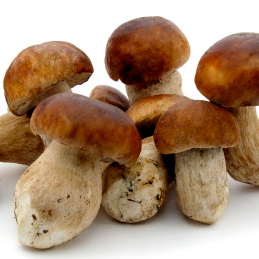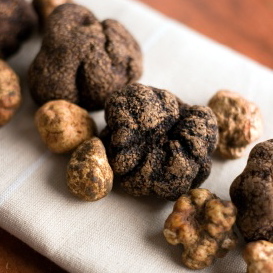
reference-image, l
(article, Ivy Manning)
[%pageBreakSettings nobreak=true] [%adInjectionSettings noInject=true] [[block(sidebar). h1.Featured recipes]] Now that autumn leaves are falling, abundant baskets of exotic mushrooms are popping up at markets everywhere. From red-headed lobster mushrooms to shapely chanterelles, we've been utterly seduced. The attraction becomes irresistible when we recall the health benefits of eating mushrooms: They can boost heart health, lower our risk of cancer, and balance our blood sugar. Here's a list of our top picks, plus what we do with the sexy things once we get them home. [[list(culinate8). #(clear n1). [%image porcini float='clear right' width=200 credit="Photo: iStockphoto/Hightower_NRW" caption="Porcini"] Known as porcini, king bolete, or cèpes, these wild mushrooms with chestnut-brown caps and bulbous white stems fetch a pretty price no matter what they're called. Stems should be firm and relatively free of insect holes and the undersides of the caps should be dry and beige, not green and sticky. Keep it simple with porcini — sauté gently or simmer in cream and toss with fresh tagliatelle to appreciate their sweet, earthy flavor. (Available July-September, plus late spring in mild climates.) #(clear n2). [%image crimini float=right width=200 credit="Photo: iStockphoto/RTimages" caption="Portobellos"] Tastier cousins of the lowly white button mushroom, cremini or crimini mushrooms sport deep brown caps and have a meatier flavor and texture than their paler kin. (Cultivated on logs or in dark growing rooms, cremini grow into portobellos when given the space and time.) Their firm texture means they hold their shape well in soups and red sauces; their low price tag lends them to stocks and consommés. (Available year-round.) #(clear n3). [%image chanterelle float=right width=200 credit="Photo: iStockphoto/The-Tor" caption="Chanterelles"] Chanterelles thrill with their elegant trumpet shape and rich golden color. Found only in the wild, these pretty 'shrooms have a chewy texture and an apricot-meets-pine-needle aroma. Choose ones with moist but not wet caps; pass on chanterelles with shriveled or frayed edges. Try them sautéed with fresh herbs in a pan sauce for seared chicken breasts. (Available June-November on the East Coast, September-February on the West Coast.) #(clear n4). [%image shiitake float=right width=200 credit="Photo: iStockphoto/blyons" caption="Shiitakes"] Shiitakes are named for the type of fallen tree they prefer to grow upon in the forests of Japan; most of the shiitakes consumed these days, however, are cultivated. Once their tough stems are removed, their buttery texture and savory flavor shine in stir-fries and sautés. Dried shiitakes, found in Asian grocery stores, have a super-meaty flavor when reconstituted; they're great in fried rice. (Available year-round.) #(clear n5). [%image lobster float=right width=200 credit="Photo © Culinate" caption="Lobster mushrooms"] A real head-turner, flame-orange lobster mushrooms aren't technically mushrooms at all; they're a parasitic mold that grows on wild fungi. Pick specimens with firm stems and dry (but not crumbly) caps. They have a musky flavor and firm texture that makes them excellent sautéed with sweet corn and cream or marinated and grilled. (Available midsummer to fall in the Northeast and Pacific Northwest.) #(clear n6). [%image oyster float=right width=200 credit="Photo: iStockphoto/kjohansen" caption="Oyster mushrooms"] The delicate lobe-shaped caps of oyster mushrooms grow in tender clusters. Most are cultivated, though occasionally more intensely flavored wild specimens turn up at farmers’ markets. This slightly chewy mushroom ranges in color from ivory white to fawn-brown and has a mild flavor that lends itself to Asian salads and soups. (Available year-round.) #(clear n7). [%image morels float=right width=200 credit="Photo: iStockphoto/kcline" caption="Morels"] Morels are a harbinger of spring, not fall — but they're definitely a fungi favorite. They sport honeycombed caps and a smoky, nutty flavor. Morels can be cultivated, though they're seldom advertised as such thanks to the "wild mushroom" mystique. Halve and rinse morels well, since their spongy texture is a veritable bug motel. Simmer them briefly in stock and serve them with grilled asparagus salad or add them to cream sauces for chicken or halibut. (Available April-June.) #(clear n8). [%image truffles float=right width=200 credit="Photo: iStockphoto/kcline" caption="Black and white truffles"] Though some experts claim our native black and white truffles don't measure up to those found in Europe, wild harvesting and initial attempts at cultivation have helped step up their quality in recent years. The hard, round fungi grow on the roots of trees and have an earthy, buttery aroma. White truffles are best shaved raw over pasta or risotto, while black truffles can be gently warmed in omelets or polenta. Be sure to buy only fragrant, ripe specimens; pass on odorless truffles or those giving off an ammonia-like funk. (Available erratically from summer to winter, especially in the Pacific Northwest.) ]] p(bio). Ivy Manning is a food journalist and cooking instructor in Portland, Oregon. She is the author of The Farm to Table Cookbook.

reference-image, l

promo-image, l

feature-image, l

crimini, l

chanterelle, l

porcini, l

oyster, l

shiitake, l

truffles, l

morels, l

lobster, l